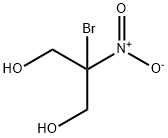Bronopol
- CAS No.
- 52-51-7
- Chemical Name:
- Bronopol
- Synonyms
- 2-BROMO-2-NITRO-1,3-PROPANEDIOL;2-BROMO-2-NITROPROPANE-1,3-DIOL;Broponol;Bronopol 1g [52-51-7];2-BroMo-2-nitropropane-1;2-Bromo-2-nitro-1,3-propanedio;2-Nitro-2-bromo-1,3-propanediol;1,3-Propanediol, 2-bromo-2-nitro-;Bronopol(2-BroMo-2-nitro-1,3-propanedio1);2-BROMO-2-NITROPROPANE-1,3-DIOL (BRONOPOL)
- CBNumber:
- CB8375786
- Molecular Formula:
- C3H6BrNO4
- Molecular Weight:
- 199.99
- MDL Number:
- MFCD00007390
- MOL File:
- 52-51-7.mol
- MSDS File:
- SDS
| Melting point | 130-133 °C(lit.) |
|---|---|
| Boiling point | 358.0±42.0 °C(Predicted) |
| Density | 2.0002 (rough estimate) |
| refractive index | 1.6200 (estimate) |
| Flash point | 167°C |
| storage temp. | Inert atmosphere,Room Temperature |
| solubility | H2O: soluble100mg/mL, clear, colorless to faintly yellow |
| form | Crystals or Crystalline Powder |
| pka | 12.02±0.10(Predicted) |
| color | White to yellow |
| Odor | odorless |
| Water Solubility | 25 g/100 mL (22 ºC) |
| Merck | 14,1447 |
| BRN | 1705868 |
| Stability | Stable. Hygroscopic. Incompatible with strong oxidizing agents, strong bases, strong reducing agents, acid chlorides and anhydrides, moisture. |
| LogP | 1.150 (est) |
| CAS DataBase Reference | 52-51-7(CAS DataBase Reference) |
| Indirect Additives used in Food Contact Substances | 2-BROMO-2-NITRO-1,3-PROPANEDIOL |
| FDA 21 CFR | 176.300 |
| FDA UNII | 6PU1E16C9W |
| NIST Chemistry Reference | Bronopol(52-51-7) |
| EPA Substance Registry System | Bronopol (52-51-7) |
| Pesticides Freedom of Information Act (FOIA) | Bronopol |
SAFETY
Risk and Safety Statements
| Symbol(GHS) |    GHS05,GHS07,GHS09 |
|||||||||
|---|---|---|---|---|---|---|---|---|---|---|
| Signal word | Danger | |||||||||
| Hazard statements | H302+H312-H315-H318-H335-H410 | |||||||||
| Precautionary statements | P261-P273-P280-P301+P312-P302+P352+P312-P305+P351+P338 | |||||||||
| Hazard Codes | Xn,N | |||||||||
| Risk Statements | 21/22-37/38-41-50 | |||||||||
| Safety Statements | 26-37/39-61-36/37/39 | |||||||||
| RIDADR | UN 3241 4.1/PG 3 | |||||||||
| WGK Germany | 2 | |||||||||
| RTECS | TY3385000 | |||||||||
| F | 4.2-8-9-21 | |||||||||
| TSCA | Yes | |||||||||
| HazardClass | 4.1 | |||||||||
| PackingGroup | III | |||||||||
| HS Code | 29055999 | |||||||||
| Toxicity | LD50 in mice, rats (mg/kg): 350, 400 orally (Croshaw) | |||||||||
| NFPA 704 |
|
Bronopol price More Price(34)
| Manufacturer | Product number | Product description | CAS number | Packaging | Price | Updated | Buy |
|---|---|---|---|---|---|---|---|
| Sigma-Aldrich | 134708 | 2-Bromo-2-nitro-1,3-propanediol 98% | 52-51-7 | 25g | $35.4 | 2024-03-01 | Buy |
| Sigma-Aldrich | 134708 | 2-Bromo-2-nitro-1,3-propanediol 98% | 52-51-7 | 100g | $109 | 2024-03-01 | Buy |
| TCI Chemical | B1247 | 2-Bromo-2-nitro-1,3-propanediol >98.0%(T) | 52-51-7 | 25g | $26 | 2024-03-01 | Buy |
| TCI Chemical | B1247 | 2-Bromo-2-nitro-1,3-propanediol >98.0%(T) | 52-51-7 | 100g | $72 | 2024-03-01 | Buy |
| Alfa Aesar | A11639 | 2-Bromo-2-nitropropane-1,3-diol, 98+% | 52-51-7 | 100g | $94 | 2024-03-01 | Buy |
Bronopol Chemical Properties,Uses,Production
Description
Bronopol, a formaldehyde releaser, was reported as an allergen in dairy workers. In a recent case report, bronopol was contained in a lubricant jelly used for ultrasound examination and caused contact dermatitis in a veterinary surgeon.
Chemical Properties
Bronopol is a white or almost white crystalline powder; odorless or with a faint characteristic odor.
Originator
Bronosol,Green Cross,Japan,1977
Uses
First synthesized in 1897, bronopol was primarily used as an effective preservative agent and possesses a wide spectrum of antibacterial activity and inhibits the growth of fungi and yeasts. It can be used in the formulation of a wide variety of cosmetic and personal care products, especially in leave-on and rinse-off shampoos, creams, lotions, rinses and eye makeup to protect the product integrity by preventing or slowing bacterial growth.
Bronopol is used as a microbiocide/microbiostat in oil field systems, air washer systems, air conditioning/humidifying systems, cooling water systems, papermills, absorbent clays, metal working fluids, printing inks, paints, adhesives and consumer/institutional products. A formulating technical material is also registered.
https://www.ulprospector.com
https://www3.epa.gov
Uses
Bronopol has been used as reference standard in ultra performance liquid chromatography (UPLC) coupled to inductively coupled plasma mass spectrometry (UPLC-ICP-MS) method for determination of bromine containing preservatives from cosmetic products.
Production Methods
Bronopol is synthesized by the reaction of nitromethane with paraformaldehyde in an alkaline environment, followed by bromination. After crystallization, bronopol powder may be milled to produce a powder of the required fineness.
Definition
ChEBI: Bronopol is a nitro compound.
Manufacturing Process
A mixture of 441 g (3 mols) of calcium chloride dihydrate, 61 g (1 mol) of nitromethane, 163 g (2 mols) of formalin (37% formaldehyde solution) and 470 ml of water was cooled to 0°C and mixed with 5 g of calcium hydroxide while stirring. The temperature thereby rose to 30°C. As soon as the temperature had fallen again, a further 32 g of calcium hydroxide (total of 0.5 mol) were added. The mixture was then cooled to 0°C and with intensive cooling and stirring, 159.8 g (1 mol, 51 ml) of bromine were dropped in at a rate so that the temperature remained at around 0°C. After the addition was ended, the mixture was stirred for a further 2 hours, when the reaction product separated in crystalline form. The product was quickly filtered on a suction filter and the crystalline sludge obtained was taken up in 450 ml of ethylene chloride and dissolved at reflux. Then by addition of magnesium sulfate, undissolved inorganic salts were separated and the solution was slowly cooled whereby 140 g (70% yield) of 2-bromo-2-nitropropane-1,3-diol precipitated in colorless crystals melting at 123°-124°C.
Therapeutic Function
Antiseptic
Biological Functions
Bronopol, 2-bromo-2-nitropropan-1,3-diol, is an aliphatic halogenonitro compound with potent antibacterial activity but limited activity against fungi(Guthrie, 1999).Its activity is reduced somewhat by 10% serum and to a greater extent by sulphydryl compounds, but is unaffected by 1% polysorbate or 0.1% lecithin. It has a half-life of about 96 daysat pH 8 and 25oC (Toler, 1985).
Bronopol is most stable under acid conditons;the initial decomposition appears to involve the liberation of formaldehyde and the formulation of bromonitroethanol. A secondorder reaction involving bronopol and formaldehyde occurs simultaneously to produce 2-hydro-xymethyl-2-nitro-1,3-propanediol, which itself decomposes with the loss of formaldehyde. 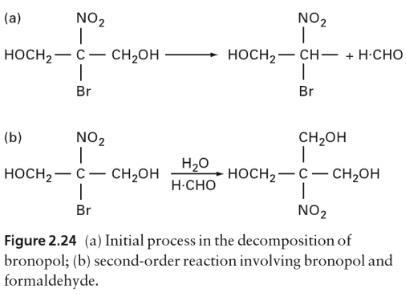
Bronopol has been employed extensively as a preservative for pharmaceuticalandcosmetic products.However, its use to preserve products containing secondary amines should be avoided as the by-product of this reaction is nitrosoamine which is carcinogenic. Details of the microbiological activity,chemical stability,toxicology and uses of bronopol are documented by Bryce et al. (1978),Croshaw & Holland (1984),Toler (1985) and Rossmorc and Sondossi (1988). Dcnyer and Wallhausser (1990) have provided useful information about bronopol, the typical in-use concentration of which is 0.01-0.1% w/v. Sulphhydryl compounds act as appropriate neutralizers inpreservative efficacy tests.
General Description
White crystals. Ignite easily and burn readily. May detonate under strong shock. Decomposes when heated, evolving toxic gases. Toxic by skin absorption, inhalation or ingestion.
Air & Water Reactions
Highly flammable. Water soluble.
Reactivity Profile
Incompatible with strong oxidizing agents, strong bases, strong reducing agents, acid chlorides and acid anhydrides. 2-Bromo-2-nitro-1,3-propanediol is also incompatible with sulfhydryl compounds or with aluminum or iron containers (it is stable in contact with tin or stainless steel).
Hazard
Toxic by all routes of exposure; skin irritant.
Health Hazard
Fire may produce irritating and/or toxic gases. Contact may cause burns to skin and eyes. Contact with molten substance may cause severe burns to skin and eyes. Runoff from fire control may cause pollution.
Fire Hazard
Flammable/combustible material. May be ignited by friction, heat, sparks or flames. Some may burn rapidly with flare burning effect. Powders, dusts, shavings, borings, turnings or cuttings may explode or burn with explosive violence. Substance may be transported in a molten form at a temperature that may be above its flash point. May re-ignite after fire is extinguished.
Pharmaceutical Applications
Bronopol 0.01–0.1% w/v is used as an antimicrobial preservative either alone or in combination with other preservatives in topical pharmaceutical formulations, cosmetics, and toiletries; the usual concentration is 0.02% w/v.
Contact allergens
Bronopol is a preservative sometimes considered as a formaldehyde releaser. It was reported to be an allergen in cosmetics, cleaning agents, dairy workers, and a lubricant jelly used for ultrasound examination.
https://www.smartpractice.com
https://www.contactdermatitisinstitute.com
Safety Profile
Poison by ingestion, subcutaneous, intravenous, and intraperitoneal routes. Moderately toxic by skin contact. An eye and human skin irritant. An antiseptic. When heated to decomposition it emits very toxic fumes of NOx, and Br-.
Safety
Bronopol is used widely in topical pharmaceutical formulations and
cosmetics as an antimicrobial preservative.
Although bronopol has been reported to cause both irritant and
hypersensitivity adverse reactions following topical use, it is
generally regarded as a nonirritant and nonsensitizing material at
concentrations up to 0.1% w/v. At a concentration of 0.02% w/v,
bronopol is frequently used as a preservative in ‘hypoallergenic’
formulations.
Animal toxicity studies have shown no evidence of phototoxicity
or tumor occurrence when bronopol is applied to rodents topically
or administered orally; and there is no in vitro or in vivo evidence of
mutagenicity; this is despite the demonstrated potential of
bronopol to liberate nitrite on decomposition, which in the presence
of certain amines may generate nitrosamines. Formation of
nitrosamines in formulations containing amines may be reduced
by limiting the concentration of bronopol to 0.01% w/v and
including an antioxidant such as 0.2% w/v alpha tocopherol or
0.05% w/v butylated hydroxytoluene;(14) other inhibitor systems
may also be appropriate.
LD50 (dog, oral): 250 mg/kg
LD50 (mouse, IP): 15.5 mg/kg
LD50 (mouse, IV): 48 mg/kg
LD50 (mouse, oral): 270 mg/kg
LD50 (mouse, SC): 116 mg/kg
LD50 (mouse, skin): 4.75 g/kg
LD50 (rat, IP): 26 mg/kg
LD50 (rat, IV): 37.4 mg/kg
LD50 (rat, oral): 180 mg/kg
LD50 (rat, SC): 170 mg/kg
LD50 (rat, skin): 1.6 g/kg
storage
Bronopol is stable and its antimicrobial activity is practically
unaffected when stored as a solid at room temperature and ambient
relative humidity for up to 2 years.
The pH of a 1.0% w/v aqueous solution is 5.0–6.0 and falls
slowly during storage; solutions are more stable in acid conditions.
Microbiological assay results indicate longer half-lives than
those obtained by HPLC and thus suggest that degradation
products may contribute to antimicrobial activity. Formaldehyde
and nitrites are among the decomposition products, but formaldehyde
arises in such low concentrations that its antimicrobial effect is
not likely to be significant. On exposure to light, especially under
alkaline conditions, solutions become yellow or brown-colored but
the degree of discoloration does not directly correlate with loss of
antimicrobial activity.
The bulk material should be stored in a well-closed, nonaluminum
container protected from light, in a cool, dry place.
Incompatibilities
Sulfhydryl compounds cause significant reductions in the activity of bronopol, and cysteine hydrochloride may be used as the deactivating agent in preservative efficacy tests; lecithin/polysorbate combinations are unsuitable for this purpose. Bronopol is incompatible with sodium thiosulfate, with sodium metabisulfite, and with amine oxide or protein hydrolysate surfactants. Owing to an incompatibility with aluminum, the use of aluminum in the packaging of products that contain bronopol should be avoided.
Regulatory Status
Included in topical pharmaceutical formulations licensed in Europe. Included in the Canadian List of Acceptable Non-medicinal Ingredients.
Bronopol Preparation Products And Raw materials
Raw materials
1of2
Preparation Products
| Supplier | Tel | Country | ProdList | Advantage | |
|---|---|---|---|---|---|
| Taicang Puyuan Pharmaceutical Co., Ltd. | +8615962375205 | China | 1 | 58 | |
| Hebei Jingbo New Material Technology Co., Ltd | +8619931165850 | hbjbtech@163.com | China | 1000 | 58 |
| Henan Fengda Chemical Co., Ltd | +86-371-86557731 +86-13613820652 | info@fdachem.com | China | 7377 | 58 |
| airuikechemical co., ltd. | +undefined86-15315557071 | sales02@airuikechemical.com | China | 994 | 58 |
| Shaanxi TNJONE Pharmaceutical Co., Ltd | +86-13474506593 +86-13474506593 | sarah@tnjone.com | China | 794 | 58 |
| Capot Chemical Co.,Ltd. | 571-85586718 +8613336195806 | sales@capotchem.com | China | 29797 | 60 |
| Henan Tianfu Chemical Co.,Ltd. | +86-0371-55170693 +86-19937530512 | info@tianfuchem.com | China | 21695 | 55 |
| Hangzhou FandaChem Co.,Ltd. | 008657128800458; +8615858145714 | fandachem@gmail.com | China | 9352 | 55 |
| Hubei XinRunde Chemical Co., Ltd. | +8615102730682 | bruce@xrdchem.cn | CHINA | 566 | 55 |
| Hefei TNJ Chemical Industry Co.,Ltd. | +86-0551-65418679 +86-18949832763 | info@tnjchem.com | China | 2989 | 55 |
Related articles
- Toxicity of Bronopol
- Bronopol strongly inhibits the growth of Gram positive and Gram negative Bacteria. It also is highly effective in eliminating ....
- Jul 25,2022
- General description of Bronopol
- Bronopol, or 2-Bromo-2-nitro-1,3-propanediol, is an organic compound with wide-spectrum antimicrobial properties. First synthe....
- Jul 1,2022
- Use of Bronopol
- Bronopol is used as a preservative in various cosmetic, pharmaceutical, toiletry and household preparations at concentrations ....
- Jan 7,2022
View Lastest Price from Bronopol manufacturers
| Image | Update time | Product | Price | Min. Order | Purity | Supply Ability | Manufacturer | |
|---|---|---|---|---|---|---|---|---|
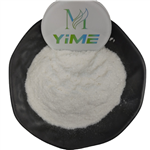 |
2024-04-16 | Bronopol 2-bromo-2-nitropropane-1,3-diol
52-51-7
|
US $15.00 / KG | 50KG | 99 | 1000kg | Hebei Yime New Material Technology Co., Ltd. | |
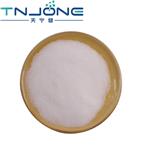 |
2024-04-11 | Bronopol
52-51-7
|
US $0.00 / kg | 1kg | 99% | 100kg | Shaanxi TNJONE Pharmaceutical Co., Ltd | |
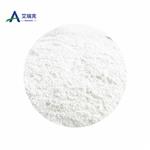 |
2024-04-10 | Bronopol
52-51-7
|
US $0.00-0.00 / Kg | 1Kg | 99.9% | 200tons | airuikechemical co., ltd. |
-

- Bronopol 2-bromo-2-nitropropane-1,3-diol
52-51-7
- US $15.00 / KG
- 99
- Hebei Yime New Material Technology Co., Ltd.
-

- Bronopol
52-51-7
- US $0.00 / kg
- 99%
- Shaanxi TNJONE Pharmaceutical Co., Ltd
-

- Bronopol
52-51-7
- US $0.00-0.00 / Kg
- 99.9%
- airuikechemical co., ltd.
52-51-7(Bronopol)Related Search:
1of4





